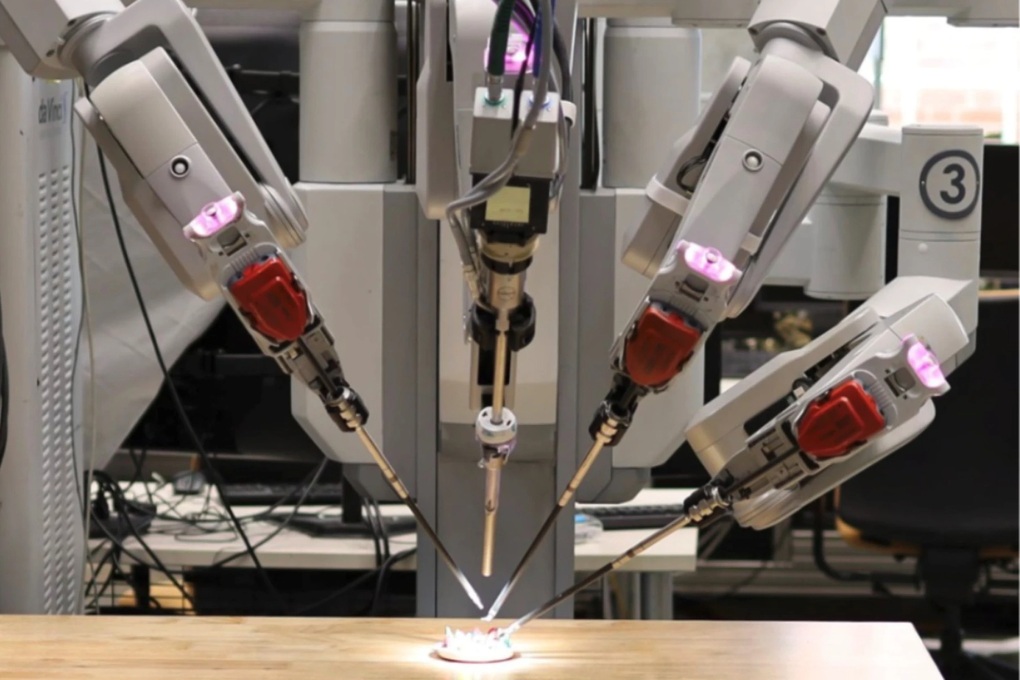An unprecedented step forward in the field of medicine has just been recorded. The world's first autonomous surgical robot SRT-H has completed a gallbladder surgery with 100% accuracy, completely without human intervention.
Although only tested on a prototype, this achievement is still considered a historic milestone, opening up the prospect of surgeon-free surgery in the near future.
Robots learn the way surgeons operate

SRT-H is capable of operating independently, self-identifying anatomical structures, handling unexpected situations and making surgical decisions (Photo: Johns Hopkins).
SRT-H (Surgical Robot Transformer-Hierarchy) is a product of a research team at Johns Hopkins University (USA).
Unlike current surgical robots that are completely dependent on the surgeon's control, such as the da Vinci system that has been used in more than 12 million surgeries since 2000, the SRT-H is capable of operating independently, recognizing anatomical structures, handling unexpected situations, and making surgical decisions almost equivalent to an experienced surgeon.
At the core of the SRT-H technology is an advanced machine learning architecture trained through a “language-guided imitation learning” approach. The technology allows the robot to learn from videos of actual surgeries performed by doctors.
This AI is also programmed to receive voice commands and respond in real-time, similar to how modern AI systems like ChatGPT operate.
Not a single mistake in the testing process
During the trial, the SRT-H was tasked with performing gallbladder resections on eight pig liver specimens with different anatomical structures, reflecting the variability when performing on real patients.
The surgery lasts several minutes, requiring the robot to flexibly use many tools such as clamps, scissors, cutters and especially the ability to make decisions on the spot.
The results stunned the scientific community. The SRT-H accurately identified the tubes and arteries, and applied the cutting technique without missing a step. This is something that even experienced doctors can make mistakes in stressful situations.

Robotic surgical hands (Photo: Johns Hopkins).
Robots still take longer to complete surgeries than humans, but the real leap forward is the ability to “understand the process” rather than just “perform the operation,” says medical robotics expert Axel Krieger, who led the research.
He likened the SRT-H to a self-driving car that can analyze all road conditions and obstacles. Previously, medical robots could not do that.
A future no longer limited by surgery and human error?
One of the project's key members believes that the reliability of AI in surgery has now reached a demonstrable level.
If further developed, robots like the SRT-H could undertake a wider range of surgeries, from simple to complex, helping to address the shortage of surgeons, reduce error rates, and standardize the quality of medical care, especially in underserved areas.
However, this is only a controlled trial. To be applied on real people, SRT-H will have to undergo a rigorous monitoring process and approval from regulatory agencies.
Not only that, autonomous surgical robots also pose many legal issues. If something goes wrong, who will be responsible: the doctor, the programmer, or the AI system itself?
Research to develop SRT-H was supported by prestigious organizations such as the Advanced Research Projects Agency for Health (ARPA-H), the National Science Foundation, and the US National Institutes of Health (NIH).
In the context of the global surgical robotics industry reaching a value of nearly 10 billion USD/year with more than 2.7 million surgeries in 2024 alone, breakthroughs like SRT-H are not only of scientific significance but also a warning that technology is advancing faster than the accompanying ethical and legal standards.
Source: https://dantri.com.vn/khoa-hoc/robot-dau-tien-phau-thuat-tu-dong-khong-can-con-nguoi-do-chinh-xac-100-20250721074245356.htm


























![[Photo] National Assembly Chairman Tran Thanh Man visits Vietnamese Heroic Mother Ta Thi Tran](https://vphoto.vietnam.vn/thumb/1200x675/vietnam/resource/IMAGE/2025/7/20/765c0bd057dd44ad83ab89fe0255b783)










































































Comment (0)